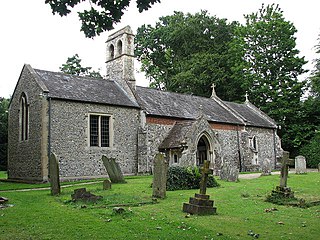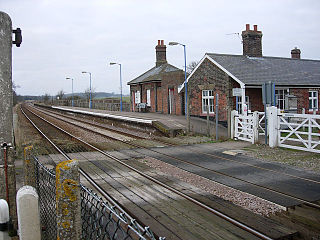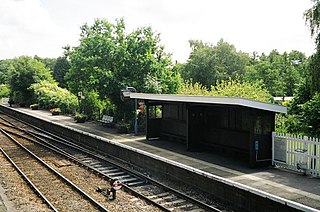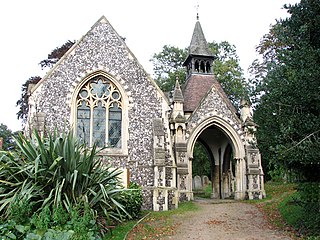The town of Morpeth in Northumberland, England, has what is reputed to be the tightest curve of any main railway line in Britain. The track turns approximately 98° from a northwesterly to an easterly direction immediately west of Morpeth Station on an otherwise fast section of the East Coast Main Line railway. This was a major factor in three serious derailments between 1969 and 1994. The curve has a permanent speed restriction of 50 miles per hour (80 km/h).

The Colwich rail crash occurred on the evening of Friday 19 September 1986 at Colwich Junction, Staffordshire, England. It was significant in that it was a high speed collision between two packed express trains. One driver was killed, but no passengers died because of the great strength of the rolling stock involved, which included examples of Mk1, Mk2 and Mk3 coaches.

The Nuneaton rail crash occurred on 6 June 1975, on the West Coast Main Line just south of Nuneaton railway station in Warwickshire, England, United Kingdom.

The Great Train Wreck of 1918 occurred on July 9, 1918, in Nashville, Tennessee, United States. Two passenger trains, operated by the Nashville, Chattanooga and St. Louis Railway ("NC&StL"), collided head-on, costing at least 101 lives and injuring an additional 171. It is considered the worst rail accident in U.S. history, though estimates of the death toll of this accident overlap with that of the Malbone Street Wreck in Brooklyn, New York, the same year.

The Wherry Lines are railway branch lines in the East of England, linking Norwich to Great Yarmouth and Lowestoft. There are 14 stations including the three termini. They form part of Network Rail Strategic Route 7, SRS 07.11 and are classified as a rural line.

Reedham railway station is on the Wherry Lines in the East of England, serving the village of Reedham, Norfolk. It is 12 miles 13 chains (19.6 km) down the line from Norwich and is situated between Cantley to the west and, to the east, Berney Arms on the Great Yarmouth branch or Haddiscoe on the Lowestoft branch. It is commonly suffixed as Reedham (Norfolk) in order to distinguish it from the station of the same name in south London. Its three-letter station code is REE.

Norwich railway station is the northern terminus of the Great Eastern Main Line in the East of England, serving the cathedral city of Norwich, Norfolk. It is 114 miles 77 chains (185.0 km) down the main line from London Liverpool Street, the western terminus.

The Breckland line is a secondary railway line in the east of England that links Cambridge in the west to Norwich in the east. The line runs through three counties: Cambridgeshire, Suffolk and Norfolk. It takes its name from the Breckland region of Norfolk and passes through Thetford Forest.

The Abermule train collision was a head-on collision which occurred at Abermule, Montgomeryshire, Wales on Wednesday 26 January 1921, killing 17 people. The crash arose from misunderstandings between staff which effectively over-rode the safe operation of the Electric Train Tablet system protecting the single line. A train departed carrying the wrong tablet for the section it was entering and collided with a train coming the other way.

Brundall is a village and civil parish in the English county of Norfolk. It is located on the north bank of the River Yare opposite Surlingham Broad and about 7 miles (11 km) east of the city of Norwich.

Buckenham railway station is on the Wherry Lines in the east of England, serving the village of Buckenham in Norfolk. It is 7 miles 62 chains (12.5 km) down the line from Norwich on the routes to Lowestoft and Great Yarmouth and is situated between Brundall and Cantley. Its three-letter station code is BUC.

Brundall railway station is on the Wherry Lines in the east of England, serving the village of Brundall, Norfolk. It is 5 miles 60 chains (9.3 km) down the line from Norwich on the route to Great Yarmouth and Lowestoft. Its three-letter station code is BDA.

Brundall Gardens railway station is on the Wherry Lines in the East of England, serving the western side of the village of Brundall, Norfolk. It is 4 miles 66 chains (7.8 km) down the line from Norwich on the routes to Great Yarmouth and Lowestoft. Its three-letter station code is BGA.
The Radstock rail accident took place on the Somerset and Dorset Joint Railway in south west England, on 7 August 1876. Two trains collided on a single track section, resulting in fifteen passengers being killed.

Rosary Cemetery was the first non-denominational burial ground in the United Kingdom. Its entrance lies on Rosary Road in Norwich, Norfolk.

The East Norfolk Railway was a pre-grouping railway company operating a standard gauge 25 mile, mostly single track, railway running between Norwich Thorpe railway station and Cromer in the English county of Norfolk. It opened in 1874, reaching Cromer three years later, and remains mostly operational. The company also operated a branch between Wroxham and County School, which closed to passengers in 1952, and had proposed a branch to Blakeney in 1878, which was never constructed.

The 1944 Ilford rail crash occurred on 16 January 1944 when, in darkness and dense fog, an express passenger train passed a signal at danger and collided with another passenger train that was stopped at Ilford railway station in Essex, England.

The Norfolk Railway was an early railway company that controlled a network of 94 miles around Norwich, England. It was formed in 1845 by the amalgamation of the Yarmouth and Norwich Railway opened in 1844, and the Norwich and Brandon Railway, not yet opened. These lines were built out of frustration that the Eastern Counties Railway line that was expected to connect Norwich to London failed to be completed. The Norfolk Railway also leased the Lowestoft Railway and Harbour company, and built a branch to Dereham and Fakenham, opened in 1846 and 1849 respectively.


















